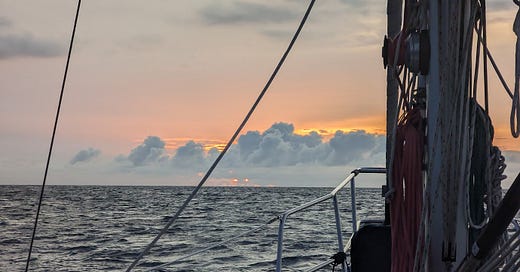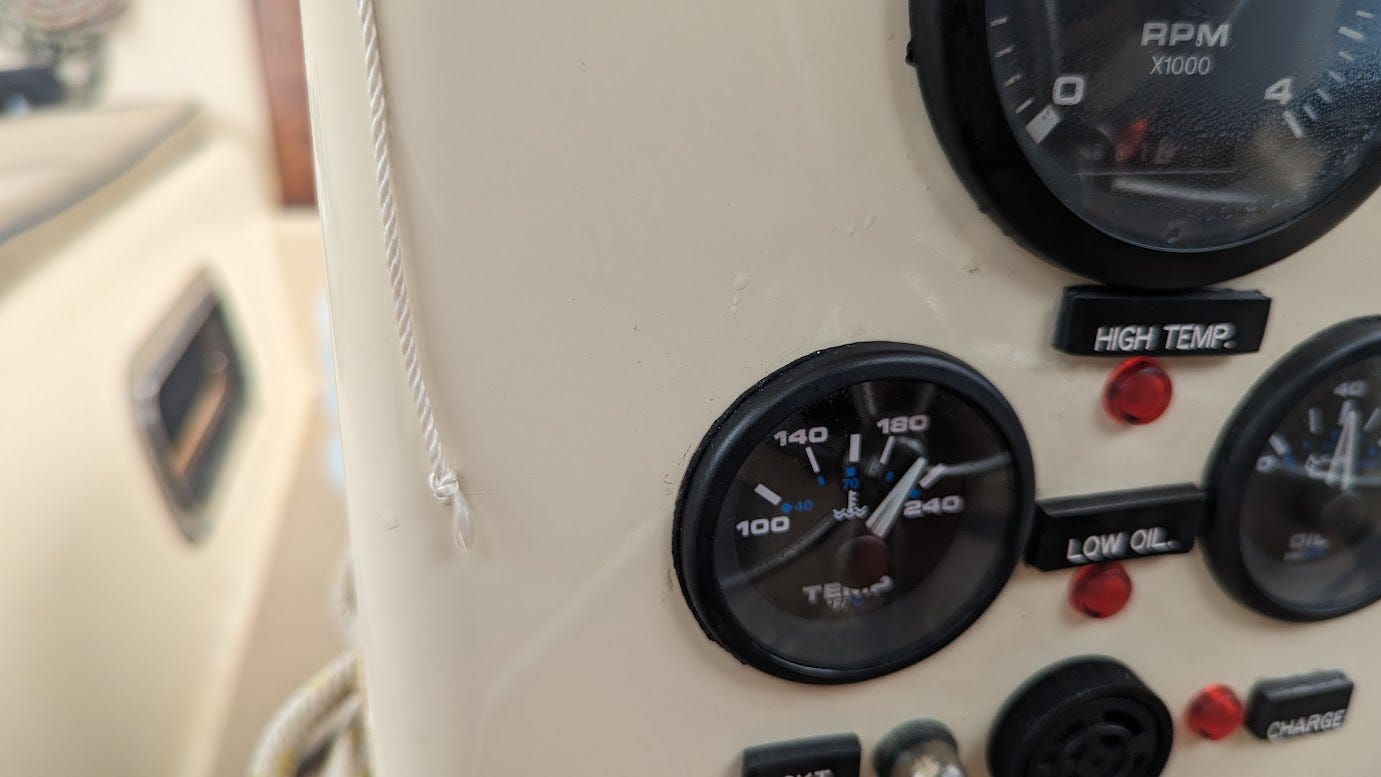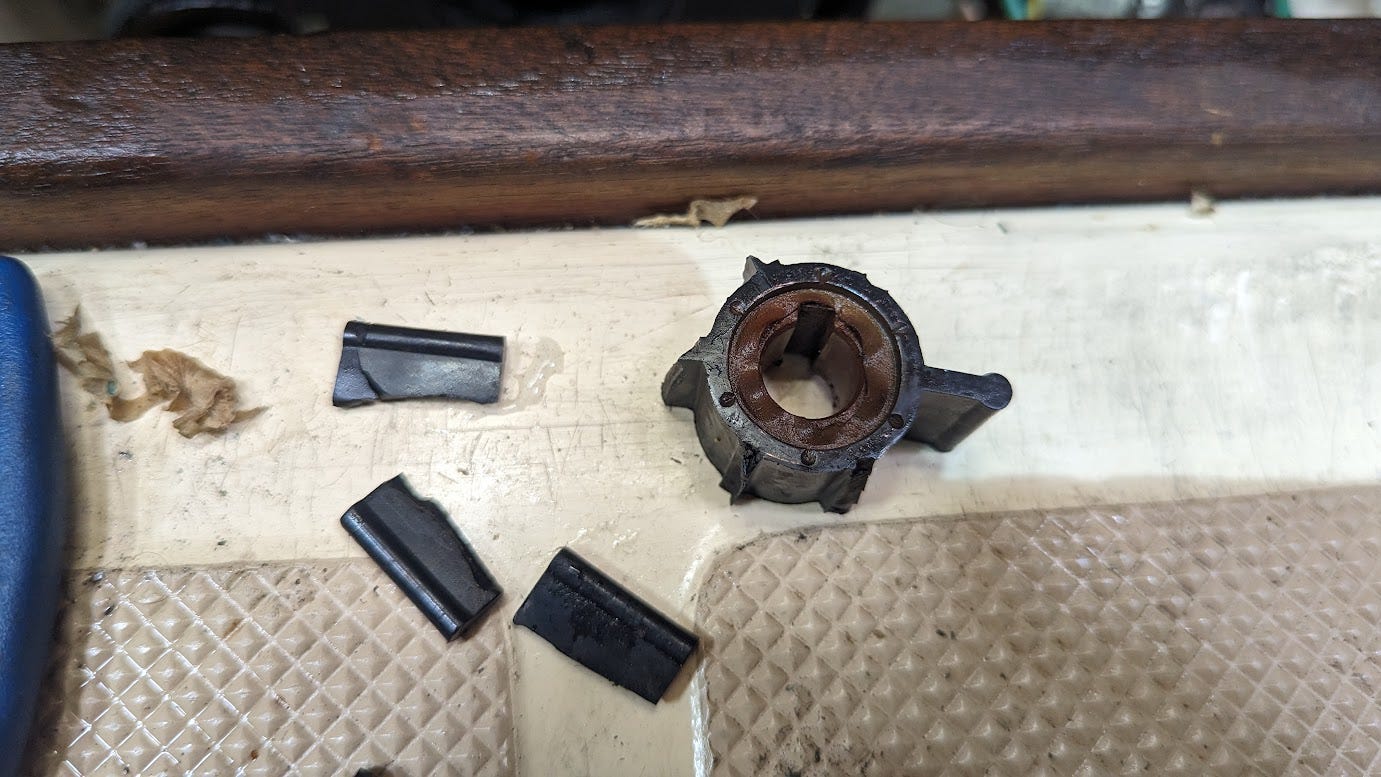[Note: this detailed account expands on a brief social media post where I intentionally glossed over the danger of our situation. We have a few family members that follow us there, already concerned about our lifestyle. I didn't want to alarm them.]
Our time in Kuna Yala was sadly cut short when our Starlink dish stopped working. It's our only means of internet access in remote places. Having comprehensive weather forecasts is vital to our safety and trip planning. Internet connects us to faraway loved ones. It also allows me to work remotely - we don't have patrons, trust funds, inheritances, or royalty checks, so we need to earn money to live and save for retirement, just like most people.
After realizing the Starlink was not going to come back to life after multiple reboots, I used faint cellular reception with a Panamanian SIM card to get a weather forecast and review options.
We'd head west, back towards the civilized world, in search of a marina where we could ship a replacement.
The next morning, I perform all the routine engine checks ahead of starting up. The wind isn't going to help us out at all, so we have at least a couple days of motoring ahead of us, with overnight anchorages to rest along the way.
We start the engine and weigh anchor, heading northwesterly out of the of San Blas bay, on a course threading through the many islands and reefs back out to open sea.
Shawn and I are chatting as I sit at the helm. Miette steers herself by autopilot, but I am still doing my instrument scan, a habit ingrained into me in flight training. Ground speed, depth, radar, course, engine RPM, engine temperature, fuel gauge, compass heading...and repeat.
There is light wind off the starboard bow, nothing we can use to sail where we need to go, so we just listen to the steady hum of the engine.
During a light snack, I point out a nearby underwater reef to Shawn, it's existence revealed only by the waves crashing into it. It's about a mile long.
I go back to my scan. Only this time, the engine temp isn't at 180°F, but right above it. A minute later, it’s even higher.
I get Shawn's attention. "We might have a problem. The engine is heading towards an overheat, and that reef is downwind of us." She comes and sits next to me, to see what I see.
It's clear that we've got a problem that could land us in imminent danger.
From the helm, I can look at our exhaust pipe, which should normally have seawater flowing out of it. Marine diesel engines pump seawater from an underwater inlet, through a cooling system, and then overboard through the exhaust. The problem is that I don't see much seawater flowing out, only a trickle.
The Guna natives, for all their pre-Hispanic charm, throw all of their trash directly into the ocean.
"Maybe there's some Guna trash clogging the intake?" I suggest.
We're in 120 feet of water, and in swell entering the bay from the Caribbean. Dropping an anchor here is out of the question.
The needle on the temperature gauge is still climbing. At some point, either the engine will seize, or the heat will start a fire in the compartment, or if we're unlucky, both.
The OODA-loop immediately comes to my mind, a tool I learned as a pilot. Observe, Orient, Decide, Act (and repeat). It's time to make a decision and act.
"One of us needs to dive the boat and check that intake." I say this as a matter of fact, but we both know I'm a poor swimmer. I have an irrational fear of drowning, but I can and do swim. Shawn looks scared, but volunteers.
"Ok, let's prepare for an engine shut-off. You'll need to hurry and get your mask because we're going to start drifting in the wind towards that reef."
We shut off Miette's diesel and our speed quickly falls off. Without the engine or sails up, the bow turns around as we start slowly drifting, bobbing like a message in a bottle. The reef is about a half mile away.
If this were happening in the US, this situation warrants a "pan pan" distress call, bordering on a full "mayday". There's no such safety net here.
I zoom into the nautical chart, mentally putting together some options.
Meanwhile, Shawn has grabbed her mask and snorkel and is getting ready to jump in the water.
"You've got this." Easy for me to say, right?
She jumps in. I'm watching her, standing next to the throwable life preserver.
She puts her head down but comes right back up, grabbing at her snorkel, her breathing is quick and shallow. I can't tell why she's struggling with it, she's been snorkeling almost every day.
She tries again but comes up, spitting water, sounding panicked.
"What's the matter?"
"I can't! The boat's moving too much!"
I look up at the reef. There must be a current pulling us - we shouldn't be moving this fast.
"Do you want your fins? They might help."
"I don't know. I don't think I can do this!" Her voice is pitched high, scared.
"Ok, get back aboard. I'll go."
Shawn watches from the water for a moment as I strip naked and start grabbing my snorkel gear.
"No. Give me my fins, I'll try again," she says, regaining her composure.
I lean overboard and hand her one swim fin at a time. She manages to get them on without drifting away. The wind on her bow, Miette has rotated about, shielding Shawn, and now we're all drifting together.
I hand her a screwdriver, for probing the intake, a small hole about 3 ft below the waterline.
"Deep breaths!" I say from the safety of the cockpit. She breaths deeply, lines herself up with the intake "through-hull" and disappears under the water.
She pops up a few seconds later.
"There's nothing there, it's clear"
"Ok. Get yourself back aboard, we need to do something about the reef."
Come on now - OODA.
We are getting closer to the reef, perhaps a quarter mile distant now, but the current is also sliding us along it's length. There is only a light wind, so raising the sails would be pointless and a waste precious time.
Shawn climbs back aboard and wraps herself with a towel, while I return to examine the observe the chart and orient ourselves.
Behind the reef are two small islands, Esnasdup East and West. A small, deep-water anchorage labeled “the pool” lays between them. I decide that it's going to have to do.
I tell her Plan A, keeping Plan B and other grim options to myself. My heart is pumping but I'm forcing slow deep breaths, keeping a clear head. After all, I'm the skipper, accountable for anything that happens to us.
After listening to the steps we're going to take, Shawns nods, ready to do her part. We are in dire straits, but composure is an elemental part of survival.
"Come on, girl. Get us through this," I say to Miette.
We start the engine and set a course to the backside of the reef. Ideally, we can get to the anchorage, but at a minimum , we should be able to get behind the reef into water shallow enough to drop anchor.
The engine had cooled, but only slightly. I raise the RPMs slightly higher than we normally cruise, but a faster RPM should mean more water flowing through the heat exchanger.
The temperature gauge begins edging upward. Mentally, I visualize every fire extinguisher we have aboard. There is one near the engine, and another in the galley. I know lowering the engine RPM now will increase the engine temperature faster, so I'm committed to keeping it there.
We sit in silence. Aside from a fire, the invisible danger is the reef underwater, now to starboard as we retrace our course. We watch our progress on the navigation screen, the minutes feeling like hours.
The last couple weeks had found us blissfully happy, anchored among the most beautiful islands we've seen yet, swimming every day in warm, clear water. How did everything go so wrong so quickly? First the Starlink, now this?
The current that gave Shawn a hard time is now a tremendous help. Our speed “over ground" is excellent. Although it's only been 10 minutes of motoring that felt like an eternity, we round the reef and turn 90 degrees to starboard with a buffer of several hundred feet to keep us out of turbulent water at it's edge. The current is still helping us. There are rusted frames of old shipping containers washed up the reef and I desperately don't want to see Miette join them.
The engine temperature is still climbing.
Miette slices through the water and we make another sharp turn past another corner of the submerged reef. We're now in 60 ft of water, still too deep to anchor, but we're protected from the long swell coming in from the Caribbean.
We approach the anchorage and there's another boat there. There appears to be just enough room for two boats, so I'll have to get it right the first time.
I tell Shawn to grab a radio and head to the bow with her polarized sunglasses, we're entering a narrow cut between reefs. She'll be double-checking our progress while I'm eyes-down, navigating.
The needle on the temperature gauge is almost as far as it can travel. There is now no evidence of any cooling water coming out of the exhaust, only an occasional puff of steam as remaining water in the system is boiled away.
As we get through the cut, I reduce engine power, and predictably, the temperature climbs even more. My heart is pounding.
I quickly pick a spot. The boat that’s already here has dropped anchor in the dead center of this tiny anchorage, so our location is far from ideal, but we'll be far enough away from the other boat for now.
"Stand by to anchor. Depth is three-five," I radio Shawn.
"Three-five," she acknowledges, then sets the radio down to ready the anchor.
This is far deeper than I'd normally choose, and will require us to put out an absurd amount of chain, but the needle on the temperature gauge is now pinned to the right.
I point the bow into the wind and shift the transmission into reverse to bring us to a standstill, and just then the “high temp” alarm begins shrieking, a solid piercing tone. Miette is yelling at me.
I immediately bring the throttle to idle and shut the engine off. The high-temp alarm silenced when I turn the key to “Off”. In the sudden silence, I can hear only by the distant white noise of waves crashing against the reef we just evaded.
"Anchor coming down!" I yell. Shawn has prepared for this by getting ready to ease the anchor off the bow roller. I press the "down" button on the windlass control, and the anchor begins descending into the deep blue hole underneath us.
This feels weird. Normally we have the engine running while we do this, slowly reversing as the chain pays out. It won't do any good to pile chain on top of the anchor, as the chain will foul the anchor.
Shawn counts off the markings she's made at 10 ft intervals on the chain.
"There's 10... 20... 30". The depth sounder now reads 37 ft. I put out a little more chain. Right now, the anchor likely is sitting on top the seabed, with the chain directly above it.
We need to wait. The wind is now blowing about 3 miles an hour, and ever so slowly, Miette starts drifting downwind. I let out a little more chain.
"That's 40" radios Shawn from the bowsprit.
I'm watching our GPS track. We drift a little bit, and I ease a little more chain out. We'll need to put out at least 160 ft of chain this way, with the bulk of it laying flat on the seabed. Anchors only dig in, or “bite”, when pulled sideways along the sea floor.
It takes 15 minutes of putting chain out 5 ft at a time until I'm confident that we have a sufficient length paid out. We know the anchor won't bury itself unless a strong wind comes up and pulls on us. For now, the weight of the chain and anchor will keep us immobile.
We wait for a minute while I ensure that we're not moving, both by the zero knots of ground speed on 3 independent GPS systems (the radio, my phone, and the chart plotter), and eyeballing the coconut trees ashore.
We're ok. If the wind shifts, we may have to hip-tie the dinghy to Miette and re-anchor, or let more chain out and stern-tie to a tree ashore. That sounds like another ordeal, and I put the thought aside. Let's deal with one problem at a time.
We catch our breaths. It's well past lunch time, and the engine is far too hot to begin troubleshooting, so we try to relax despite the adrenaline surging through us. I open the engine compartment and within a minute, the cabin feels like an oven.
There is activity on the other boat and she soon weighs anchor and motors away, her crew waving goodbye. We’re alone, as these islands are uninhabited.
We eat a quick lunch, then jump in the water to cool off while Miette does the same, all her escape hatches and portlights open.
The water feels good, and I’m glad we’re swimming voluntarily and not for our lives. We're safe, and I have enough experience with this engine to have a plan of attack. We still have a radio and a little bit of mobile data if we need to call for assistance.
Later that afternoon, I use an infrared laser thermometer to check the temperatures of engine parts I want to access. I don't want a painful burn adding to my list of problems. Everything is between 110-120 by now, hot but manageable. I know what not to touch.
The first suspect is the raw water pump, and when I remove and open it, it's clearly the culprit. Inside is a rubber impeller, like a small paddle-wheel. When it rotates, it pumps seawater up to the engine's heat exchanger.
The problem is that, of the 6 rubber paddles, 5 have broken off. Before I replace the impeller, I have to account for all the missing pieces, as they can block the flow of water. After 30 minutes, I have lined up each of the missing pieces against the hub, sure that I have extracted them all.
In a prior post (Transiting the Panama Canal), I describe how the Canal advisor pushed us to run the engine as hard as possible through the canal. It may be that long hours at a sustained high temperature made our rubber impeller brittle. It’s hard to say. When we’ve bought spares, there’s no telling how long something has sat on a store’s shelf before going into storage on the boat, so age might have been a factor, too.
An hour has passed and a bandana keeps the sweat from pouring into my eyes. With a spare impeller installed and the pump mounted back on the engine, we look at each other hopefully. It’s time to find out if this fixed the problem.
We go through our engine starting checklist. I turn the key and the engine comes to life.
Immediately I look at the exhaust, but there's still no water coming out. Shit. I'd primed the pump, flooding it with seawater, so there shouldn't be an air pocket defeating the suction. What the hell? My eyes are on the temperature gauge but it's not yet registering anything. It usually doesn't for a couple minutes.
I feel deflated, and start thinking about what to try next.
Just before I reach for the engine cut-off handle, there's a cough and sputter, and a stream of water finally emerges from the exhaust!
I grin at Shawn! She's still in a bikini and she loves swimming, so when I suggest she jump in and get a better look at the exhaust, she goes right in.
Smiling, she says "there's plenty of water coming out!"
The temperature gauge has reached the 150°F mark and stays there, a normal temperature for idle on this engine. I watch a minute or two longer, jump in the water with Shawn to kiss her (and shed the sweat I’m soaked with).
I quickly scramble back aboard and check the temperature again and see it's held steady. It's a well-worn cliché among sailors, but cruising really is “fixing your boat in a series of exotic places”.
This anchorage is protected from nearly every direction, and we'd love to stay and explore, but duty calls and I've left my work team in a lurch.
We don't even spend the night. Instead, we burn the remaining daylight getting to the edge of the San Blas archipelago, weighing a decision to press onward through the night.
As the sun sets, an ominous pair of red eyes stare at us from the west. I’m not superstitious, but this seems like a clear sign not to continue onwards. At dusk, we tuck-in behind a reef at the entrance to the bay, carefully following our GPS tracks from a couple weeks before, and dropping anchor in 10 feet of placid water.
By 8pm, we turn out the lights and are asleep within minutes.






Love/hate this post! So glad you made it and survived engine problems. Thank goodness you found all the pieces of the impeller.